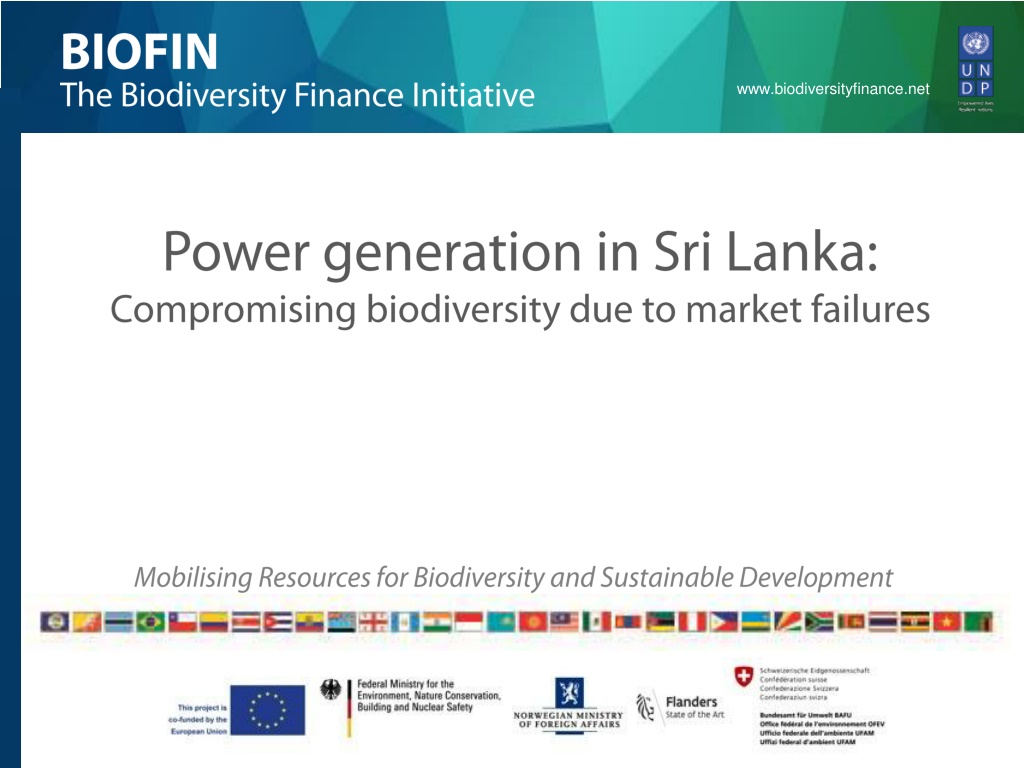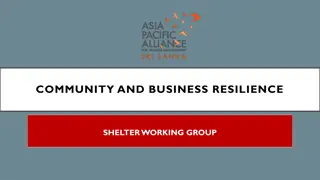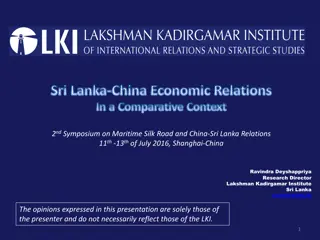Challenges and Opportunities in Sri Lanka's Energy Sector
Sri Lanka's energy landscape faces various challenges including reliance on coal, exhausted hydro power capacity, and low efficiency in power generation. Major issues involve considering coal without accounting for externalities, low hydro plant factors, and government vs. private ownership. Improving plant factors of hydro stations like Nilambe and Udawalawe is crucial for enhancing energy production efficiency and sustainability.
Download Presentation

Please find below an Image/Link to download the presentation.
The content on the website is provided AS IS for your information and personal use only. It may not be sold, licensed, or shared on other websites without obtaining consent from the author. Download presentation by click this link. If you encounter any issues during the download, it is possible that the publisher has removed the file from their server.
E N D
Presentation Transcript
Sri Lanka- Pearl of Indian Ocean www.biodiversityfinance.net Sri Lanka
Country at a glance www.biodiversityfinance.net Population 21 million Land area 65,610 km2 GDP Per capita 3,835 USD (2016) GDP Per capita (PPP) 12,811 USD (2017) Livelihoods Agriculture Industries Services Electrification level 99.3% Per capita electricity consumption 626.3 kWh 26.1% 28.4% 45.5%
www.biodiversityfinance.net Electricity Generation Mix- Sri Lanka 2016 Electricity Generation Capacity- 2016 8% Hydro 12% 24% Coal 36% Hydro Oil Coal 32% Oil Non conventional RE 30% Non conventional RE 36% 22%
Generation Vs Capacity www.biodiversityfinance.net CAPACITY TO GENERATE VS ACTUAL GENERATION %- 2016 159.1 106.7 66.7 66.7 Hydro Coal Oil Non conventional RE
Cost of production www.biodiversityfinance.net COST OF PRODUCTION - USD CTS/KWH Without accounting for environmental costs 18.74 11.48 6.8 3.45 HYDRO COAL OIL NON CONVENTIONAL RE
Main issues www.biodiversityfinance.net Assuming coal as the best way forward as externalities are not being considered Exhausted hydro power generation capacity Low efficiency of existing hydro power generators Government owned Private owned
Hydro power issues www.biodiversityfinance.net Plant factor = Actual energy production during a given period Potential energy production during that period All major power plants operated below 50% plant factor Only 5 plants out of 17 operated with more than 40% plant factor 5 plants operated with less than 20% plant factor
Plant factor of major hydro stations-2016 www.biodiversityfinance.net PLANT FACTOR OF HYDRO ELECTRICITY STATIONS-2016 15.40% Nilambe 29.50% Udawalawe 42.20% Inginiyagala 32.90% Kukule 24.70% Samanalawewa 17.90% Upper Kotmale 12.00% Bowatenna 45.00% Ukuwela 33.10% Rantambe 30.20% Randenigala 31.90% Victoria 15.80% Kotmale 49.30% Polpitiya 42.40% New Laxapana 23.30% Canyon 50.40% Old Laxapana 19.30% Wimalasurendra
Many mini hydro plants operate at sub optimal levels www.biodiversityfinance.net Number of mini hydro operators against plant factors 18 0% to 10% 42 10% to 20% 45 20% to 30% 31 30% to 40% 15 40% to 50% 4 50% to 60% 0 5 10 15 20 25 30 35 40 45
Main reasons major hydro power plants www.biodiversityfinance.net Erratic rainfall (Climate Change impacts) Reducing water holding capacity of reservoirs due to siltation Prioritization of irrigation requirements (to irrigate large areas water is being diverted before generating electricity)
Main reasons mini hydro power plants www.biodiversityfinance.net Inadequate water flow during the dry season Poor land use management in the catchment Vandalism People living in surrounding areas see mini hydro operators as aliens who have come to the area only to make profits
Solutions www.biodiversityfinance.net Both major and mini hydro operators want to see a catchment of better health condition Need to invest on soil conservation and promote improved land use practices Need to understand the causal effect relationship between mismanagement of catchment and the poor water flow Create interdependent symbiotic relationship between the plant operators and the land holders in the catchment
www.biodiversityfinance.net Sensitizing power generation in Sri Lanka to environment realities Payment for Eco system Services Understanding the externalities of coal and fossil fuel based power generation Setting up a mechanism for major hydro power plants where.., Buyer = electricity consumers Seller= Land owners of upper catchment Setting up a mechanism for mini hydro power plants where.., Buyer = private plant operators Seller= Land owners of upper catchment
BIOFIN support to the government www.biodiversityfinance.net Work with Public Utilities Commission of Sri Lanka (PUCSL) to study the externalities of coal power generation Work with Ministry of Mahaweli Development and Environment and PUCSL to initiate a PES scheme in Moragahakanda reservoir Work with IUCN to initiate a PES with a mini hydro operator























